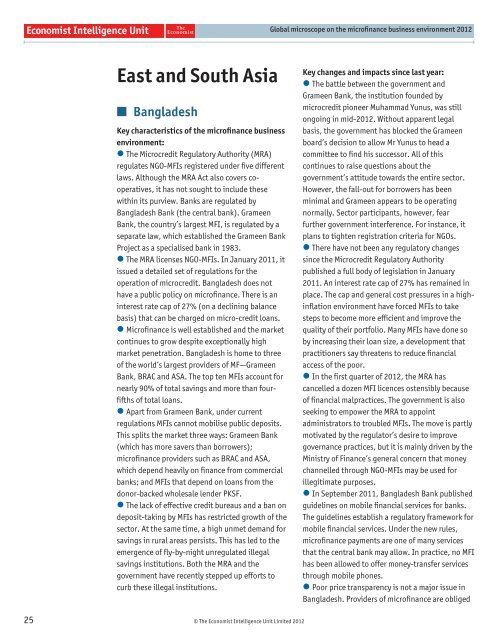Global microscope on the microfinance business environment 2012
Global microscope on the microfinance business environment 2012
Global microscope on the microfinance business environment 2012
Create successful ePaper yourself
Turn your PDF publications into a flip-book with our unique Google optimized e-Paper software.
25<br />
East and South Asia<br />
■ Bangladesh<br />
Key characteristics of <strong>the</strong> microfi nance <strong>business</strong><br />
envir<strong>on</strong>ment:<br />
l The Microcredit Regulatory Authority (MRA)<br />
regulates NGO-MFIs registered under fi ve different<br />
laws. Although <strong>the</strong> MRA Act also covers cooperatives,<br />
it has not sought to include <strong>the</strong>se<br />
within its purview. Banks are regulated by<br />
Bangladesh Bank (<strong>the</strong> central bank). Grameen<br />
Bank, <strong>the</strong> country’s largest MFI, is regulated by a<br />
separate law, which established <strong>the</strong> Grameen Bank<br />
Project as a specialised bank in 1983.<br />
l The MRA licenses NGO-MFIs. In January 2011, it<br />
issued a detailed set of regulati<strong>on</strong>s for <strong>the</strong><br />
operati<strong>on</strong> of microcredit. Bangladesh does not<br />
have a public policy <strong>on</strong> microfi nance. There is an<br />
interest rate cap of 27% (<strong>on</strong> a declining balance<br />
basis) that can be charged <strong>on</strong> micro-credit loans.<br />
l Microfi nance is well established and <strong>the</strong> market<br />
c<strong>on</strong>tinues to grow despite excepti<strong>on</strong>ally high<br />
market penetrati<strong>on</strong>. Bangladesh is home to three<br />
of <strong>the</strong> world’s largest providers of MF—Grameen<br />
Bank, BRAC and ASA. The top ten MFIs account for<br />
nearly 90% of total savings and more than fourfi<br />
fths of total loans.<br />
l Apart from Grameen Bank, under current<br />
regulati<strong>on</strong>s MFIs cannot mobilise public deposits.<br />
This splits <strong>the</strong> market three ways: Grameen Bank<br />
(which has more savers than borrowers);<br />
microfi nance providers such as BRAC and ASA,<br />
which depend heavily <strong>on</strong> fi nance from commercial<br />
banks; and MFIs that depend <strong>on</strong> loans from <strong>the</strong><br />
d<strong>on</strong>or-backed wholesale lender PKSF.<br />
l The lack of effective credit bureaus and a ban <strong>on</strong><br />
deposit-taking by MFIs has restricted growth of <strong>the</strong><br />
sector. At <strong>the</strong> same time, a high unmet demand for<br />
savings in rural areas persists. This has led to <strong>the</strong><br />
emergence of fl y-by-night unregulated illegal<br />
savings instituti<strong>on</strong>s. Both <strong>the</strong> MRA and <strong>the</strong><br />
government have recently stepped up efforts to<br />
curb <strong>the</strong>se illegal instituti<strong>on</strong>s.<br />
© The Ec<strong>on</strong>omist Intelligence Unit Limited <strong>2012</strong><br />
<str<strong>on</strong>g>Global</str<strong>on</strong>g> <str<strong>on</strong>g>microscope</str<strong>on</strong>g> <strong>on</strong> <strong>the</strong> microfi nance <strong>business</strong> envir<strong>on</strong>ment <strong>2012</strong><br />
Key changes and impacts since last year:<br />
l The battle between <strong>the</strong> government and<br />
Grameen Bank, <strong>the</strong> instituti<strong>on</strong> founded by<br />
microcredit pi<strong>on</strong>eer Muhammad Yunus, was still<br />
<strong>on</strong>going in mid-<strong>2012</strong>. Without apparent legal<br />
basis, <strong>the</strong> government has blocked <strong>the</strong> Grameen<br />
board’s decisi<strong>on</strong> to allow Mr Yunus to head a<br />
committee to fi nd his successor. All of this<br />
c<strong>on</strong>tinues to raise questi<strong>on</strong>s about <strong>the</strong><br />
government’s attitude towards <strong>the</strong> entire sector.<br />
However, <strong>the</strong> fall-out for borrowers has been<br />
minimal and Grameen appears to be operating<br />
normally. Sector participants, however, fear<br />
fur<strong>the</strong>r government interference. For instance, it<br />
plans to tighten registrati<strong>on</strong> criteria for NGOs.<br />
l There have not been any regulatory changes<br />
since <strong>the</strong> Microcredit Regulatory Authority<br />
published a full body of legislati<strong>on</strong> in January<br />
2011. An interest rate cap of 27% has remained in<br />
place. The cap and general cost pressures in a highinfl<br />
ati<strong>on</strong> envir<strong>on</strong>ment have forced MFIs to take<br />
steps to become more effi cient and improve <strong>the</strong><br />
quality of <strong>the</strong>ir portfolio. Many MFIs have d<strong>on</strong>e so<br />
by increasing <strong>the</strong>ir loan size, a development that<br />
practiti<strong>on</strong>ers say threatens to reduce fi nancial<br />
access of <strong>the</strong> poor.<br />
l In <strong>the</strong> fi rst quarter of <strong>2012</strong>, <strong>the</strong> MRA has<br />
cancelled a dozen MFI licences ostensibly because<br />
of fi nancial malpractices. The government is also<br />
seeking to empower <strong>the</strong> MRA to appoint<br />
administrators to troubled MFIs. The move is partly<br />
motivated by <strong>the</strong> regulator’s desire to improve<br />
governance practices, but it is mainly driven by <strong>the</strong><br />
Ministry of Finance’s general c<strong>on</strong>cern that m<strong>on</strong>ey<br />
channelled through NGO-MFIs may be used for<br />
illegitimate purposes.<br />
l In September 2011, Bangladesh Bank published<br />
guidelines <strong>on</strong> mobile fi nancial services for banks.<br />
The guidelines establish a regulatory framework for<br />
mobile fi nancial services. Under <strong>the</strong> new rules,<br />
microfi nance payments are <strong>on</strong>e of many services<br />
that <strong>the</strong> central bank may allow. In practice, no MFI<br />
has been allowed to offer m<strong>on</strong>ey-transfer services<br />
through mobile ph<strong>on</strong>es.<br />
l Poor price transparency is not a major issue in<br />
Bangladesh. Providers of microfi nance are obliged















![Joint Report on Social Protection and Social Inclusion [2005]](https://img.yumpu.com/19580638/1/190x132/joint-report-on-social-protection-and-social-inclusion-2005.jpg?quality=85)
